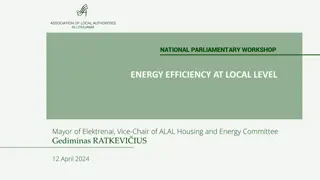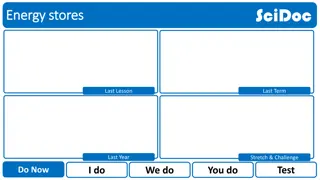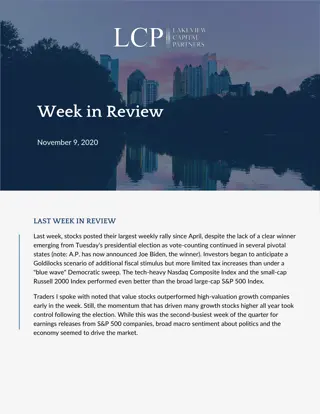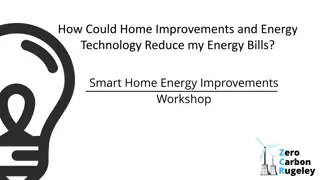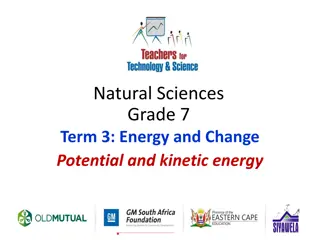
Energy Industry Expectations Under Biden Administration
The Biden Administration's impact on the energy sector, including sources in the US, primary production and consumption data, electricity generation breakdown, and additional requirements for satisfying transportation needs through renewables.
Download Presentation

Please find below an Image/Link to download the presentation.
The content on the website is provided AS IS for your information and personal use only. It may not be sold, licensed, or shared on other websites without obtaining consent from the author. If you encounter any issues during the download, it is possible that the publisher has removed the file from their server.
You are allowed to download the files provided on this website for personal or commercial use, subject to the condition that they are used lawfully. All files are the property of their respective owners.
The content on the website is provided AS IS for your information and personal use only. It may not be sold, licensed, or shared on other websites without obtaining consent from the author.
E N D
Presentation Transcript
What the Energy Industry Can Expect from the Biden Administration Keith Bradley Alexandra McCluskey
Energy Sources in the United States Natural Gas 31.8% Petroleum 28% Coal 17.8% Renewable Energy 12.7% Nuclear electric power 9.6% Source: www.americangeosciences.org, 2017
EIA Data Total Energy Production and Consumption Production Consumption
Energy Consumption by Transportation In 2019, 28% of US energy produced was used by transportation.
Electricity Generation Breakdown In 2020, the US produced 4 trillion kilowatt hours of electricity from all sources Fossil Fuels produced a collective 60.35% Coal 19.3% Petroleum 0.44% Natural Gas 40.33% Other Gases 0.28% To replace fossil fuels used to generate electricity with renewables, renewables will need to generate 2.4 trillion additional kilowatt hours of electricity per year. This does not account for increased demand for electricity, which the EIA predicts will grow by 1.3% by 2022.
Additional Electricity Required To Satisfy Transportation Needs If the current US transportation system was weaned from petroleum and converted to fully electric, we would need to replace 220 trillion BTU from petroleum with 644 billion KWH from renewables. Additional 16% of electric generation needed to supply the current transportation system. This is in the transportation sector only not industrial, residential or commercial consumption For context, 1 solar panel can generate 1.5 kwh with 5 hours of sunlight.
Currently, the ten largest wind farms in the United States are: Project Capacity (MW) State 1548[8] Alta Wind Energy Center California 912[13] Los Vientos Wind Farm Texas 845[14] Shepherds Flat Wind Farm Oregon 801[15] Meadow Lake Wind Farm Indiana 781[16] Roscoe Wind Farm Texas Horse Hollow Wind Energy Center 736 Texas Tehachapi Pass Wind Farm 705 California Capricorn Ridge Wind Farm 662 Texas San Gorgonio Pass Wind Farm 619 California 601[17] Limon Wind Energy Center Colorado The Traverse Wind Energy Center, located in Oklahoma and with a capacity of 999 MW, will surpass Los Vientos as the second-largest wind farm upon coming online in 2021.
Petroleum and Natural Gas Other Uses Despite the push to move away from Petroleum and Natural Gas as fuel sources, demand for their production will not disappear. Petroleum is used in one form or another in the manufacturing of virtually everything in our modern world, as the fuel of choice in emergency situations. As the medical response to COVID demonstrated, the products and medicines that ensure our safety and health are made with plastics, petrochemicals and petroleum. Then there s everything else in our every day lives made from petroleum products.
Oil and gas is used in renewable energy infrastructure Steel & Concrete Production Solar Panels (petrochemicals) Wind Turbines (carbon fiber) Storage Transportation of the energy itself, and shipping components for manufacturing parts To create the renewable energy and associated infrastructure needed to replace energy from fossil fuels, it would require more fossil fuel production than we currently produce.
Renewable Energy Capacity and Storage Reality Manhattan Institute, 2019: In practical terms, this means that spending $1 million on utility-scale wind turbines, or solar panels will each, over 30 years of operation, produce about 50 million kilowatt-hours (kWh) while an equivalent $1 million spent on a shale rig produces enough natural gas over 30 years to generate over 300 million kWh. Solar and wind technologies have met their physics boundary for gains in efficiency Storage capacity currently can only store 3 minutes worth of annual US electricity demand
Energy from fossil fuels is cheap. More wind and solar capacity in Europe has led to higher electricity prices.
Takeaways? The Biden Administration has promised a shift toward renewable energy sources and away from fossil fuels, and to be carbon neutral by 2050. An enormous task Current renewable technology cannot support it, more R&D required Need for oil and gas production will not go away, might actually increase during the transition Coal will probably continue to phase out because other sources are cheaper
As of January 20, 2021, where was the US energy industry? Like every other industry, recovering from 2020 Facing legislative uncertainty (tax plan, jobs act, democratic control of both houses of congress) Record low oil prices and volatility Layoffs in both oil and gas and renewables, shifting labor force Funding difficult to get for oil and gas projects, directed toward renewable energy instead For oil and gas, losing its PR battle against green energy New opportunities in renewable energy, energy-reliability tech
Texas Blackouts and California Wildfires Causes? Texas: Structure of power industry, but also increased reliance on wind energy On February 15, 2021 - Natural Gas 65%, Coal 18%, Wind 6% and Solar 2%. On February 15, 2020 Natural Gas 43%, Coal 14%, Wind 28% and Solar 2%. California: negligence in maintaining brush and trees along transmission lines, failure to repair damaged system More frequent extreme weather events? High winds and dry climate are nothing new to most of California. Regulatory hurdles to upgrading the system The results? (Aside from the nation s most populous states being cold, dark, or on fire) Litigation Increased demand for on-site energy systems rather than reliance on large power grid
Bidens Energy Policy From Joebiden.com: Joe Biden s Plan for a Clean Energy Revolution Take executive action on Day 1 to not just reverse all of the damage Trump has done [to the climate] but go further and faster. Work with Congress to enact legislation in 2021 that, by the end of his first term, puts the US on an irreversible path to achieve economy-wide net-zero emissions no later than 2050. Rally the world to urgent and additional climate action. Make historic investment in clean energy and innovation. Make environmental justice a priority across all federal agencies. Hold polluters accountable Create 10 million good-paying, middle-class union jobs. Fulfill our obligation to the communities and workers that have risked their lives to produce fossil fuels that made it possible for America to win world wars and become an industrial power
Translation: Promote renewable energy development Punish fossil fuel industry Create union jobs Protect poor communities from pollution and displacement Enact regulatory mandates and increase enforcement Renewable energy only makes up about 11-12% of total US energy and over the last 10 years, has been slowly gaining in production capabilities and consumption. Fossil fuels make up 77% and had a record year of production in 2019. Energy consumption has risen in every economic sector, aside from 2020, when consumption dropped due to government responses to COVID.
New Union Jobs According to the Bureau of Labor Statistics, in 2020, Unions made up 10.8% (14.3 million) of wage and salary workers in the US. In 1983, union membership was 20.1% (17.7 million). Most union members are public sector workers (34.8% public vs. 6.3% private). Where will these jobs be in a green energy economy? Where the energy is. See MAP Will the jobs be stable? Will they be high paying like oil and gas?
Obstacles to long-term job creation In power generation sector, most employment will be in temporary construction jobs rather than as permanent jobs as plat operators Jobs in construction are often jobs for those without college degrees boom in employment, short term
Will the jobs really be unionized? Absent legislation making it easier for workers to unionize, it will be difficult to add new union jobs to solar and wind sectors. Even if it passes, it will take a lot of time for unionization rates to catch up to coal and gas power sectors. Supreme court precedent exists which states that you cannot force people to join a union.
It is April 15, 2021. What has the Biden Administration done to further it s goals? Signed more executive orders than any president has in history by April 8 in their respective presidencies Jobs Act (infrastructure) proposed Tax Plan announced Policy announcements on climate, energy
Executive Orders as of April 8, 2021 Date Topic Type Reversal Summary 02/24/2021 Economy Executive Order Yes Revokes a series of seven Trump administration actions that had eased environmental regulatory requirements, among other things 02/24/2021 National Security Executive Order No Launches a 100-day review of US supply chains for pharmaceuticals, critical minerals, semiconductors and large-capacity batteries, directing agencies to identify opportunities to secure and invest in those supply chains. It also calls for a year-long review into six sectors: Defense, public health and biological preparedness, information and communications technology, energy, transportation, and agricultural commodities and food preparation 01/27/2021 Environment Executive Order No Elevates climate change as an essential element of US foreign policy and national security and kicks off development of a new emissions reduction target, which will be announced by April 22; halted new leases on federal lands and waters 01/27/2021 Environment Executive Order No Reestablishes the President s Council of Advisors on Science and Technology 01/27/2021 Environment Memo No Charges the director of the Office of Science and Technology Policy with responsibility for ensuring scientific integrity across federal agencies 01/20/2021 Environment Other Yes Rejoins the Paris climate accord, a process that will take 30 days 01/20/2021 Environment Executive Order Yes Cancels the Keystone XL pipeline and directs agencies to review and reverse more than 100 Trump actions on the environment
Shut-down of Keystone XL Pipeline Executive order Signaling that new pipeline development generally is not likely to happen during next 4 years Immediate effects: Job losses, Lost work on 300 miles of the line that have already been completed Strained relations with Canada Loss of $3 billion in contracts which would have been awarded to construction contractors and US steel suppliers
Policy Announcement - Jump Starting Wind Energy Development March 29, 2021 White House statement calls on our nation to build a new American infrastructure and clean energy economy that will create millions of new jobs. Promotes large, offshore wind projects off the Atlantic Coast, Gulf of Mexico and Pacific waters. New priority wind energy area announced through the Interior Department s Bureau of Ocean Energy Management (BOEM) in the New York Bight (shallow waters between Long Island and the New Jersey Coast). Lease sale projected in late 2021 or early 2022. $12 billion per year in capital investment in wind projects. BOEM to advance new lease sales and complete review of at least 16 Construction and Operations Plans by 2025. Increase demand for steel, windfarm components, turbine installation vessels, port infrastructure improvements.
March 31, 2021 - American Jobs Plan Among many other things, the plan aims to reenergize America s power infrastructure. Calls on congress to invest $100 billion to: Build a more resilient electric transmission system Spur jobs modernizing power generation and delivering clean electricity Put the energy industry to work plugging orphan oil and gas wells and cleaning up abandoned mines Mobilize the next generation of conservation and resilience workers
Continued American Jobs Plan also asks congress to provide funding to make housing and buildings more energy efficient Introduces an investment tax credit for high voltage transmission lines 10-year extension of existing tax credits for solar and wind energy Invest $174 billion in electric vehicles, tax incentives to consumers to buy the vehicles, and proposing new grant and incentive programs to build 500,000 electrical-vehicle chargers by 2030, shifting the federal fleet (including USPS) to electric vehicles, and mandating that federal buildings only use clean energy sources.
Bidens Tax Plan Tilting the playing field in favor of renewable energy Replaces U.S. Fossil Fuel subsidies with clean energy incentives Elimination of fossil fuel subsidies estimated to add $35 billion to federal coffers over next 10 years Oil and Gas deductions slated for elimination: Intangible drilling cost deduction, which allows oil and gas producers to deduct most of the costs associated with finding and preparing wells. This deduction has been around since 1913. Percentage over cost depletion, which effectively helps oil and gas companies lower taxable income. This deduction has been around since 1926. Long-term impact on oil production and greenhouse gas emissions is questionable Real impact is a political.
Tax plan continued Incentives to renewable energy 10-year extension to production and investment tax credits for clean energy and storage projects Provides long term legislative stability for renewables, a break from past trends Intended to accelerate production Direct-pay options for clean energy and carbon capture credits less reliance on tax equity funding Incentives for long-distance transmission projects to ease cost allocation issues for new lines. Studies estimate that the US will need to double or triple transmission capacity to meet the goal of decarbonizing the power sector by 2035. Proposals include a 30% tax credit for new lines.
Questions? Keith Bradley, kbradley@bradleyhammondlaw.com, (817) 645-3993, North Texas Alexandra McCluskey, amccluskey@bradleyhammondlaw.com, (412) 533-2620, Pittsburgh
Sources https://www.eia.gov/totalenergy/data/monthly/ https://www.bls.gov/news.release/pdf/union2.pdf https://whitehouse.gov https://www.wsj.com/articles/bidens-infrastructure-plan-where-the- money-is-going-11617211939?mod=searchresults_pos19&page=3 https://www.energyindepth.org/petroleum-products-and-you-oil- and-gas-materials-used-in-hospitals-to-save-lives/ https://www.bloomberg.com/news/ https://www.wsj.com/articles/big-oils-influence-shrinks-as-tax-perks- face-axe-in-biden-plan-11618398180
Sources continued https://www.spglobal.com/marketintelligence/en/news- insights/blog/essential-energy-insights-march-2021 https://media4.manhattan-institute.org/sites/default/files/R-0319-MM.pdf https://napipelines.com/dca-widespread-job-loss-kystone-xl-termination/ https://www.reuters.com/article/us-usa-biden-keystone/tc-energy-cuts- jobs-as-keystone-pipeline-nixed-but-markets-start-to-move-on- idUSKBN29Q1T8 https://www.independent.org/news/article.asp?id=13447#:~:text=Overall %20for%20the%20year%202020,a%20higher%20share%20than%20coal. https://www.forbes.com/sites/scottcarpenter/2021/01/19/the-challenge- facing-bidens-green-jobs-agenda-green-jobs/?sh=6d600c243acc



